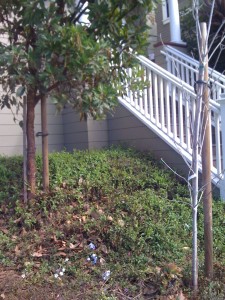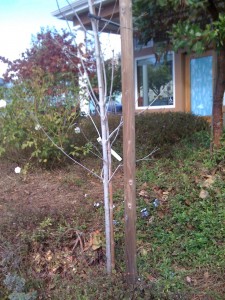
Southern Magnolia – Proper staking, but left too long. Also this tree should have low, temporary branches removed.
There are times when trees require staking but all staking should be temporary. Unfortunately, more often than not, tree stakes are left in place too long and damage the tree!
Stakes are needed at planting time in areas of strong wind or if the tree needs support standing vertical on it’s own. In urban areas, young trees are often double or triple staked to survive the urban environment and vandalism.
Any stakes used at the time of planting should be removed within one to two years time. All too common is the scenario where a tree stake causes major wounds and injury to a tree as the tree grows larger.
Many trees come from the store with a stake tied in multiple spots against their trunk. This nursery stake should always be removed at the time of planting. If the tree needs to be staked for support or protection, stakes should be put on the outside of the root ball at planting and lashed to the tree at one height with supple, non-restrictive material.

Another example of nursery stake left on large tree too long. This stake will certainly damage the truck of this Strawberry tree if not removed soon.

Too much staking for a small tree. The nursery stake has been left on and it was planted with a second lodge pole stake. Both have now outgrown their usefulness.
As soon as the tree has rooted into the new location, remove those stakes!
Trees need to sway in the wind to develop healthy structure and wounds to the bark that stakes and rigid staking will cause can let harmful fungus and disease into the tree.


You must be logged in to post a comment.